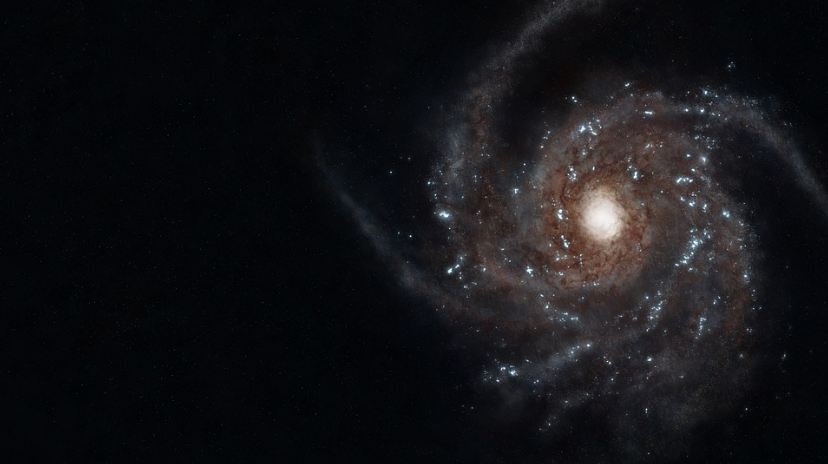With over 200 billion galaxies in the whole Universe, the Milky Way is the most famous of all galaxies as it comprises our Solar System. It is the most significant to humans and all living organisms as it is the home sweet home. Let’s take a look at the Milky Way.
How Big Is the Galaxy Milky Way?
It is the second-largest galaxy in the Local Group, next to Andromeda Galaxy. Including its stellar disk, the Milky Way is a barred spiral galaxy approximately 170,000–200,000 light-years in diameter and about 890 billion times the Sun’s mass. To compare the relative physical scale of the Milky Way, if the Solar System out to Neptune were the size of a US quarter, it would be approximately the contiguous United States size.
There is a ring-like filament of stars rippling above and below the relatively flat galactic plane, wrapping around the Milky Way at a diameter of 150,000–180,000 light-years (46–55 kpc), which may be part of the Milky Way itself.
Where Is It Located?
Even without a professional telescope, you can see the Milky Way’s visible region galactic plane that occupies an area of the sky that consists of 30 constellations. But don’t you know that even if it seems endless in our eyes, we only see about 0.000003% percent of it! The Galactic Center lies in Sagittarius’s direction, the point where the Milky Way is at its brightest.
The hazy band of white light coming from Sagittarius appears to pass around to the galactic anti center in Auriga, then continues the rest of the way around the sky, back to Sagittarius, dividing the sky into two roughly equal hemispheres. The Milky Way is continuously rotating, and the Sun and the solar system travel with their movement. Even though the solar system moves at an average speed of 515,000 mph, it still takes about 230 million years to travel around the Milky Way.
Age of the Milky Way
Studying the age of the Milky Way Galaxy can also be done by studying globular clusters, the oldest objects in it. You can estimate individual stars’ ages through the technique called nucleocosmochronology. Measure the abundance of long-lived radioactive elements such as thorium-232 and uranium-238, then compare the results to their original abundance estimates.
The Universe is about 13.8 billion years old, and most galaxies age between 10 billion and 13.6 billion years old, as most galaxies formed when the Universe was relatively young. Astronomers theorized that the Milky Way galaxy is approximately 13.6 billion years old. The youngest galaxy known was formed only about 500 million years ago.
In November 2018, astronomers discovered one of the oldest stars, 2MASS J18082002-5104378 B, about 13.5 billion years old. It’s a tiny ultra-metal-poor (UMP) star composed entirely of materials released from the Big Bang. This gives the theory that if that is one of the first stars in the Milky Way, it suggests that the Galaxy may be at least 3 billion years older than previously thought.
There is a supermassive black hole at the very center of the Galaxy, right at its very core, and its presence is evident and can be felt because of gravity’s presence. Stars near and even those billion kilometers away cannot escape this monster at the black hole. But there is nothing humans to worry about it because Earth is very far from the black hole, about 250,000,000,000,000,000 kilometers away.
Significant Facts About the Milky Way
- There are almost 200 billion stars in the Milky Way, with enough gas and dust to produce billions more.
- The solar system is around 30,000 light-years away from the galactic core and 20 light-years above the galaxy’s plane. Earth and its satellites do not orbit on the galaxy plane but rather at an angle of around 63 degrees.
- Moreover, half of the stars in the Milky Way are much older than the Sun, which is 4.5 billion years old. Around 10 billion years ago, galaxies like ours had a stellar baby boom, spewing out massive amounts of stars.
- Red dwarfs, which are cold stars approximately a tenth of the Sun’s mass, are the most numerous stars in the galaxy. Red dwarfs were once considered unsuitable for probable life planets since such worlds would have to be too nearby to fit the criteria. Still, they are now being evaluated as candidates.
- Astronomers believed that the Milky Way contained all of the stars in the cosmos until the 1920s. Astronomers didn’t understand the fuzzy patches traditionally categorized as nebulae were different galaxies until Edwin Hubble discovered a peculiar star called a Cepheid variable, which enabled him to estimate distances precisely.
How Astronomers Gather Data
It has long been challenging to comprehend the structure of the Milky Way. No one can see over the dense center to the other half of the solar system, which lies on the outside margins of an arm in a disk of material.
So how do astronomers gather data and study the celestial bodies that are way too far from us? Of course, the obvious answer to that is through technological advancement. The discovery of equipment and tools needed to observe the Universe and everything around it is the immediate help.
With the Use of the Hubble Space Telescope
NASA’s observatory instrument, Hubble Space Telescope, comprises three types of devices that analyze light from the Universe: cameras, spectrographs, and interferometers.
1. Camera
Hubble uses two primary camera systems to capture images of the cosmos: The Advanced Camera for Surveys (ACS) and the Wide Field Camera 3 (WFC3). The ACS is mainly designed for wide-field imagery in visible wavelengths; it can detect ultraviolet and near-infrared light. Both ACS and WFC3 systems work together to provide superb wide-field imaging over a comprehensive range of wavelengths.
2. Spectrographs
Spectroscopy is the science that studies the different parts of light, including how a prism scatters white light into a rainbow. Subjects of this study are objects absorbing and emitting light. The study helps in determining temperature, density, chemical composition, and velocity.
3. Interferometers
Hubble’s interferometers help the telescope maintain a steady aim and serve as a scientific instrument. Fine Guidance Sensors are the three interferometers aboard Hubble that measure the relative positions and brightness of stars.




